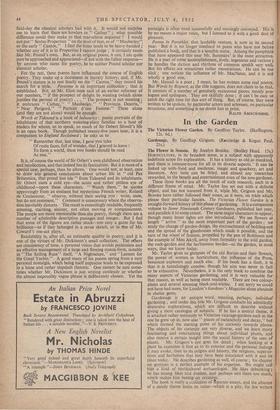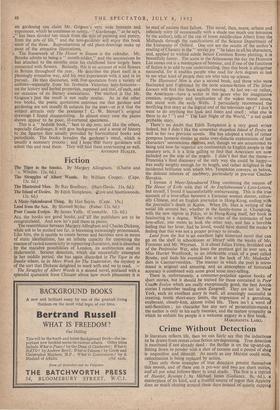In the Garden
The Victorian Flower Garden. By Geoffrey Taylor. (Skeffington. 12s. 6d.) Gardenage. By Geoffrey Grigson. (Routledge & Kegan Paul. 21s.) - The Flower in Season. By Jocelyn Brooke. (Bodley Head. 15s.) HORTICULTURE, in its broadest sense, is a subject with apparently indefinite scope for exploration. It has a history as old as mankind, and there is treasure-trove for all in its diverse aspects, It can be linked up with food and medicine, magic and quackery, art and literature. Any taste can be fitted, and almost any researches rewarded, to the benefit and entertainment even of the non-gardener. These three books are all the result of such research, each in a different frame of mind. Mr. Taylor has set out with a definite object, and has not wavered from it, while Mr. Grigson and Mr. Brooke have rather followed their noses, as it were, on trails which please their particular fancies. The Victorian Flower Garden is a straight-forward history of this phase of gardening. It is a companion volume to Some Nineteenth Century Gardeners, published last year, and parallels it to some extent. The same major characters re-appear, though many lesser lights are also introduced. We see flowers at length " arrive " as the most important part of the garden ; we study the change of garden-design, the encroachment of bedding-out and the spread of the glasshouses which made it possible, and the turn of the wheel of fashion, propelled by the pen of Robinson and the example of Miss Jekyll, away from formality to the wild garden, the rock-garden and the herbaceous border—to the garden, in most ways, that we know today. Mr. Taylor gives us glimpses of the old florists and their flowers, the power of women in horticulture, the influence of the Press, botanical explorers and much else. If his book has a fault, it is that it is tantalisingly concise, though his aim was never in fact to be exhaustive. Nevertheless, it is the only book to combine the many aspects of Victorian gardening, and it is very valuable for that reason, as well as being most readable. There are two colour- plates and several amusing black-and-whites. I am sorry we could not have had more, for Loudon's Gardener's Magazine alone abounds in choice gems.
Gardenage is an antique word, meaning, perhaps, individual gardening ; and under this title Mr. Grigson conducts his admittedly discursive explorations, which are difficult to describe without giving a mere catalogue of subjects. If he has a central theme, it is attached rather tenuously to Victorian vicarage-gardens such as the one he grew up in, now alas " places of melancholy and decay," but which formed the starting point of his curiosity towards plants. The objects of his curiosity are very diverse, and we learn many fascinating and entertaining things about individual planti, and also receive a certain insight into the social history of the uses of plants. Mr. Grigson's eye goes for detail ; when looking at a plant he examines it first as to its exterior and the personal feelings it may evoke, then to its origins and history, the religions, supersti- tions and herbalism that may have been associated with it and its place today. He describes gardening as well, of course • his chapter on grottoes is a perfect example of his expertise. We might call him a kind of horticultural archaeologist. , He likes debunking ; he has strong likes and dislikes, and perhaps airs theni too much, which makes him boring ,on occasion. The book is really a collection of Iparate essays, and the absence of a steady theme limits its value—which is a pity, for few writers on gardening can claim Mr. Grigson's very wide interests and experience, which he combines so subtly. " Gardenage," as he says, ,." has been divided too much from the arts of painting and poetry, from the arts of life," and the non-gardener will enjoy this book most of the three. Reproductions of old plant-drawings make up most of the attractive illustrations.
► The framework of The Flower in Season is the calendar. Mr. Brooke admits to being a " month-addict," and the associations he has attached to the months since his childhood have largely been connected with flowers. Basically, this is an account of wild flowers ; in Britain throughout the year. He describes the plant itself in a I pleasingly evocative way, and his own experiences with it and in its pursuit. He then discourses, with free quotation from a variety of authors—especially from his favourite Victorian lady-botanists- on the history and herbal properties, supposed and real, of each, and on occasion of its literary associations. The method is like Mr. Grigson's (but the result is not really similar. As in the other two books, the poetic quotations convince me that gardens and gardening are not usually fit subjects for the poet—or is it that the subject attracts only the poetaster ? C. W. Stewart's original drawings I found disappointing. In almost every case the plants shown appear to be poor, ill-nurtured specimens.
This is a " bedside book," best to dip into, and like the others, especially Gardenage, it will give background and a sense of history to the Spartan fare usually provided by horticultural books and \ periodicals. The books broaden the gardener's mind, which is usually a necessary process ; and I hope that many gardeners will admit this and read them. They will find them entertaining as well. ANTHONY HUXLEY.



























































 Previous page
Previous page